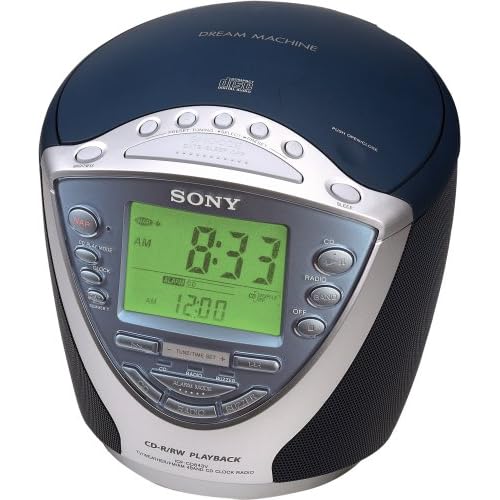
In my bedroom there are five devices with alarm clock capabilities: two regular alarm clocks, a cell phone, a laptop, and an mp3 player. None of these devices are particularly reliable or easy to use and they all function differently. With many of them, setting an alarm--a task that many people need to do daily--is as difficult as setting the clock on a DVD player or microwave.
My Sony Dream Machine ICF-CD843V (shown above) is the best among these evils. A quick look at its Amazon listing reveals many of its problems. One reviewer submits this one-star entry:
"I NEED SOMEONE TO TELL ME HOW TO SET THE CLOCK RADIO. I PRESS CLOCK ON THE SIDE BUT NOTHING HAPPENS AFTER I PRESS THE UP AND DOWN BUTTONS. HELP!"
There's even a post on eHow.com explaining how to set the alarm. And this is the best of the five options that I own! But for an experienced user such as myself, knowing how to set an alarm is not the problem. The problem is actually doing it.
Last Tuesday, I slept through a class presentation because I had failed to notice that the alarm was set for PM instead of AM from the previous day's afternoon nap. While this problem is rare, it consistently happens to me at least once every few months. This is not an acceptable failure rate; I need an alarm clock that I can trust to work every time. Nor is this problem the user's fault; the alarm time's AM/PM marker is tiny and is not located in the standard position after the time. Go ahead and see if you can find it in the picture above. Now pretend that you're exhausted and it's dark in the room. Not easy, is it? (hint: it's to the left of 12:00)
One solution to this problem, discussed by Don Norman in The Design of Everyday Things is to use 24-hour military time, or (even better) metric time. But standards should rarely be ignored in cases like this. A user seeing 21:00 may be confused or think that his alarm clock is broken. Worse, a user wishing to nap until 8:00PM may just set the alarm for 8:00 military time and sleep until the next morning.
Another possibility is to employ a forcing function, whereby users are required to hit either an AM or PM button after entering the time. This forces the user to consider which time has been selected, rather than relying on the previous time to be in the correct 12 hour ballpark. This is surely a better solution than the existing system, but there's always the problem of hitting the wrong button by accident. Tired users are particularly prone to errors such as this, but at least this solution provides a pause for people to consider the AM/PM decision, preventing them from skipping over it.
My best idea that so far is a slider design:

As you can hopefully see (sorry for the crappy jpeg; Blogger is giving me problems), the alarm time is set by two sliders: one for hours, one for minutes. The hour slider clicks at discrete intervals, while the minute slider can be adjusted continuously. A switch and corresponding LED activate the alarm and provide feedback. In the picture above, the alarm is set for 6:38AM.
This design eliminates the need to distinguish between AM and PM, since the slider covers an entire day. It is also very fast and intuitive to set. A snooze feature could either be implemented in the traditional way or a user could simply adjust the bars for another 10 minutes of sleep.
I'll be the first to admit that this design isn't perfect. First, I wasn't sure whether to include 12:00AM and :00 respectively at the end of the sliders. I could easily see a user setting the alarm for 6:30AM one day and then moving the minute slider all the way to the right the next day, intending to set the alarm for 30 minutes later. This problem could probably be fixed by ending the sliders at 11:00PM and :59, respectively.
Second, this design does not address countless other problems with alarm clocks. One common issue is accidentally turning off the alarm without waking up. There are lots of fun designs that try to address this problem in some pretty creative ways. I haven't addressed these here, though.
Anyways, I'd appreciate some feedback! Can you see any problems with the slider design? Do you have alternative ideas? Insightful stories about bad alarm clock experiences would be appreciated as well.



